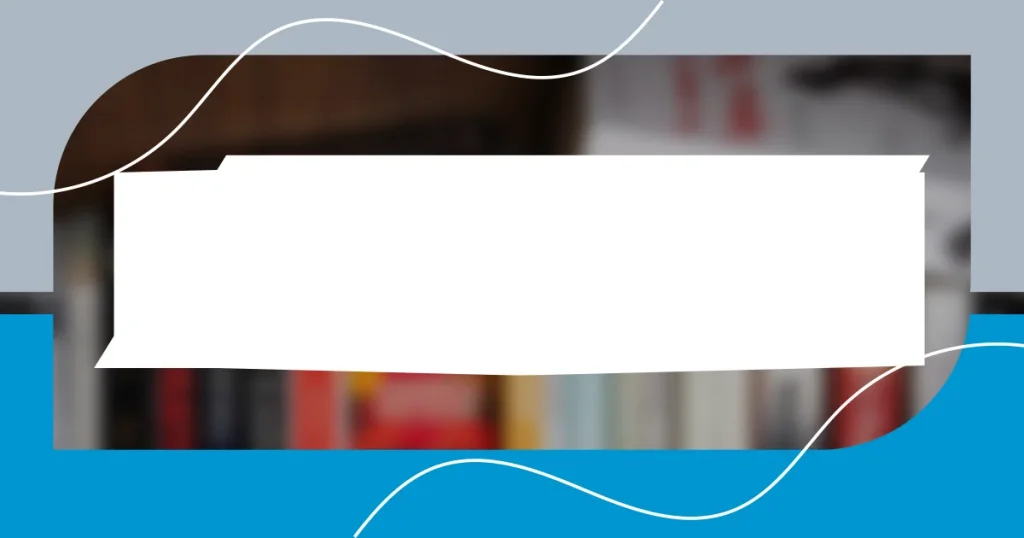Key takeaways:
- Genre tropes provide a familiar framework for storytelling, enabling creators to connect with audiences through shared experiences while also allowing for creative subversion.
- Understanding audience expectations is crucial to crafting compelling narratives, as both meeting and defying these expectations can deepen emotional engagement and provoke thoughtful reactions.
- Balancing originality with familiarity enriches stories, as blending well-known tropes with unique perspectives can create relatable narratives that resonate on a personal level.

Understanding genre tropes
Genre tropes are those familiar themes, character types, or plot devices that we often encounter across various works. I remember the first time I noticed a trope; I was watching a romantic comedy and couldn’t help but smile when the “meet-cute” happened. It got me thinking—why do certain story elements resonate so deeply with us? They tap into our shared experiences and emotions, making us feel connected to the narrative.
As I dove deeper into writing, I learned that tropes serve a purpose—they provide shorthand for storytelling, allowing both creators and audiences to engage more easily. Have you ever found yourself predicting the next line in a thriller just because a character walked into a dark alley? I find it thrilling, yet comfortingly predictable. Recognizing these patterns helps us appreciate how they shape narratives while also giving us room to subvert them creatively.
Engaging with tropes can feel like a dance; sometimes, I lean into them, while other times, I spin away to surprise my readers. Just the other day, I was brainstorming a fantasy novel and decided to flip the “chosen one” trope on its head. Instead of a single hero, I created a team of misfits who grow together, challenging the notion of individualism in epic tales. It’s these kinds of explorations that lead to fresh stories and keep the genre vibrant.

Identifying common genre tropes
Identifying genre tropes can feel like a treasure hunt. I remember the moment I recognized the “mentor” character in various stories. It dawned on me how many narratives rely on that wise guide figure who often takes the protagonist under their wing, offering wisdom and training. Some might see it as cliché, but there’s something comforting about it, isn’t there? It creates expectations and familiar dynamics that can either delight or challenge.
To help you see how prevalent tropes are across genres, consider these common examples:
- Romantic comedy: The “opposites attract” scenario where two unlikely partners find love.
- Fantasy: The “chosen one” destined to save the world.
- Mystery: The “trustworthy informant” who has inside knowledge but is often hiding something.
- Horror: The “final girl” who survives when everyone else falters.
- Science fiction: The “distant future with advanced technology” where societal issues are magnified.
As I reflect on my own writing journey, I’ve learned to distinguish these patterns, which not only informs my storytelling but also enriches my reading experience. Each trope has its own flavor, evoking specific emotions and setting the stage for either predictability or surprise in the narrative unfolding before us.

Analyzing audience expectations
Analyzing audience expectations is crucial in storytelling. When I write, I often think about what readers are anticipating and how I can either meet or defy those expectations. It’s fascinating to observe how audiences react to familiar tropes. For example, in a mystery novel, if the detective starts to unravel the case too easily, I sense a collective sigh from the readers. They crave the thrill of twists and turns, and I make it my mission to deliver just that—unexpected surprises that keep them on the edge of their seats.
I’ve also found that knowing the audience’s typical reactions to certain genres can help me craft more compelling narratives. The last time I wrote a horror story, I decided to play with the expectation of a sudden scare at the end. Instead, I focused on building a slow, creeping dread, which engaged my readers in a different way. They didn’t know what to expect, and that uncertainty held them captive. It’s these subtle shifts in expectations that lead to deeper emotional connections with my audience.
Understanding these aspects allows me to create stories that resonate on multiple levels. I remember when I read a fantasy novel, and the hero’s journey was wonderfully predictable—yet I found myself craving something different. It inspired me to weave in characters that brought humor into dire situations, challenging the traditional heroic mold. So, in analyzing audience expectations, I see it as a pathway not just to meet their desires, but to surprise and delight them in ways they might not have anticipated.
| Genre | Common Expectations |
|---|---|
| Mystery | Complex puzzles and unexpected twists |
| Romantic Comedy | Feel-good moments and predictable romance |
| Horror | Jump scares and inevitable doom |
| Fantasy | Epic quests with clear-cut heroes |

Subverting genre conventions
Subverting genre conventions is one of my favorite strategies when writing. I remember crafting a romance where instead of the typical “happily ever after,” the characters chose to pursue individual dreams over a relationship. It felt exhilarating to flip the script and challenge the readers’ expectations. I could sense their surprise, and through that, I realized how powerful it can be to dare to diverge from the norm.
In my experience, flipping common expectations not only adds depth but also invites readers to rethink their preconceived notions. For instance, I’ve played with the horror genre by introducing a non-traditional monster—one that embodies social fears rather than supernatural elements. That approach led my audience to reflect on real-world terrors instead of simply bracing for another jump scare. This got me thinking: how often do we overlook the fears that linger just beneath the surface?
Every time I challenge these conventions, it’s not just about being different; it’s about exploration. I think about a fantasy story I wrote where the “chosen one” was unexpectedly the villain, and what should have been a straightforward adventure turned into a moral dilemma. It raised questions about destiny and choice, sparking meaningful discussions among readers. Isn’t it intriguing how a simple shift in perspective can transform the entire narrative? You find that when conventions are subverted, stories can breathe new life and complexity into familiar themes.

Creating unique character arcs
Creating unique character arcs is essential for captivating stories. I often think about how a character’s journey can mirror real-life growth. For instance, I once wrote a protagonist who initially seemed selfish but gradually learned the power of vulnerability. This slow transformation allowed me to explore themes of connection and empathy, surprising readers who expected a straightforward redemption arc.
Reflecting on my own experiences, I’ve found that characters resonate more when they face genuine obstacles. In a recent project, I created a mentor figure who harbored deep-seated regrets. Rather than merely guiding the hero, this character’s personal struggles became a pivotal part of the plot. It led me to ponder: what if the one we look up to has their own journey of growth? This layered approach not only enriched the story but also deepened the readers’ engagement with both the mentor and the hero.
In my opinion, truly unique character arcs often emerge when I ask myself difficult questions about identity and change. I remember crafting a dual narrative where two characters started on opposing paths but inadvertently grew to influence each other’s beliefs. The crossover moments were exciting—they prompted me to think about how interconnected our lives can be. Isn’t it fascinating how our characters can challenge and reshape each other, creating a shared evolution that feels authentic and profound?

Incorporating fresh plot twists
Incorporating fresh plot twists can truly elevate a story, pulling readers into unexpected emotional landscapes. I remember a time when I was weaving a mystery and decided to reveal the killer in the middle instead of the classic end twist. The initial reaction from my small group of beta readers was sheer disbelief—but that’s exactly what I wanted! It opened up the narrative to explore motives and consequences rather than just who-done-it questions. Have you ever thought about how shifting the focus can create a richer experience for your audience?
One of my favorite techniques is to introduce a twist rooted in character backstory. During a recent project, I crafted a seemingly innocent side character who harbored a shocking secret— a connection to the main antagonist! This not only complicated the plot but also gave my readers a chance to reexamine everything they thought they knew about the characters. I could feel the tension build as I wrote those scenes, and it was exhilarating. It makes me wonder: how often do we truly consider the layers behind even the smallest roles in our stories?
I find that incorporating twists feels most satisfying when they reflect real-life unpredictability. In a fantasy tale I wrote, I created a prophecy that led the hero to believe they had to sacrifice everything for a greater good, only to discover that their true power lay in forging connections instead. This twist not only surprised readers but also sparked discussions on the nature of destiny versus choice. Isn’t it amazing how a well-placed twist can resonate on a relatable level, leaving a lasting impression and inviting deeper reflection?

Balancing originality with familiarity
Finding the right balance between originality and familiarity can feel like walking a tightrope. I’ve often said that a touch of the expected makes a story more accessible, while a fresh twist keeps it exciting. A few years ago, I wrote a romance where I consciously played with the classic “enemies to lovers” trope, injecting unexpected hobbies and interests that broke conventional molds. My aim was to intrigue readers while anchoring them in a narrative structure they already loved. Doesn’t that give you the best of both worlds?
In my journey as a writer, I’ve realized that combining familiar themes with personal experiences is where the magic happens. For instance, I took a well-known fantasy quest and infused it with my own memories of travel and discovery. When my characters encountered obstacles reminiscent of my backpacking adventures, it brought authenticity to their struggles. Have you ever felt a connection to a story because it echoed moments from your life?
Ultimately, I believe that originality doesn’t mean abandoning tropes entirely; it means reshaping them to reflect our unique realities. When I recently worked on a science fiction piece, I decided to reimagine the usual dystopian setting by highlighting the beauty of small revolutions in everyday life—inspired by grassroots movements I’ve witnessed. This blend of a familiar genre with novel perspectives created a story that felt both fresh and resonant. How do you infuse your voice into your narratives while using established conventions?
















